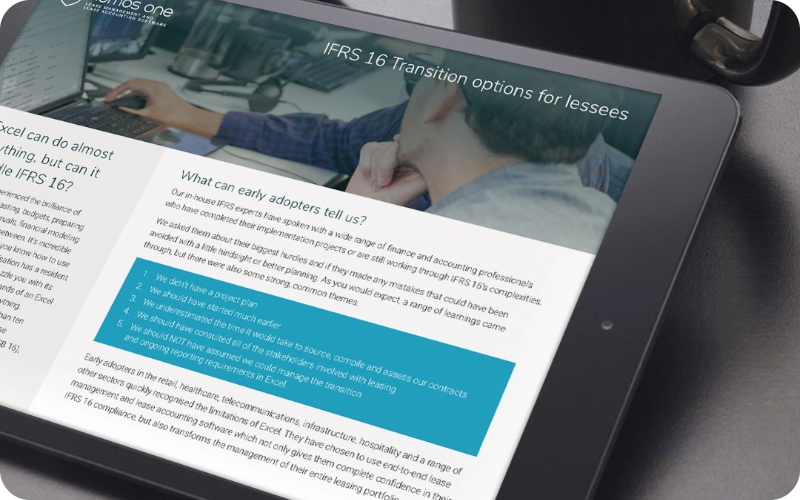The adoption of IFRS 16 in the private sector brought significant changes to lease accounting by requiring lessees to recognise nearly all leases on balance sheet. While this shift posed numerous challenges, it also provided valuable insights for organisations now preparing to transition to IPSAS 43. Public sector entities in New Zealand can learn from the experiences of private companies, ensuring a smoother and more efficient transition while mitigating risks and avoiding the pitfalls encountered during IFRS 16 implementation.

Early planning and preparation
A major lesson from IFRS 16 adoption is that many organisations underestimated the complexity of the transition including the time and resources required. Businesses that delayed their implementation often faced last-minute compliance issues, data gaps, and unexpected costs and found themselves scrambling to collect lease data, interpret new accounting treatments, and adjust their financial reporting processes. For public sector entities, starting early is crucial as waiting too long can overburden finance teams, lead to data inconsistencies, and increase the risk of errors. However, by taking a proactive approach, creating a structured transition roadmap, assigning dedicated teams, allocating sufficient resources, and ensuring leadership support, organisations can avoid the last-minute rush that led to compliance issues in the private sector.
Lease data collection and validation
For private sector companies, gathering and validating lease data was the most challenging and time-intensive aspect of IFRS 16 compliance. Many businesses struggled with decentralised lease records, missing contracts, incomplete financial details, and non-standardised documentation. Public sector entities, which often operate across multiple departments and agencies, may face even greater difficulties in consolidating lease information. To avoid these issues, public sector entities should take proactive steps to centralise lease data, implement a structured review process, introduce consistent documentation practices, and encourage close collaboration between departments responsible for lease management and lease accounting. Verifying that lease data is complete, accurate, and up to date will prevent last-minute compliance roadblocks. Establishing a single source of truth for lease data will prevent inefficiencies and errors during IPSAS 43 compliance efforts.
Limitations of manual lease management
During IFRS 16 implementation, organisations that initially relied on spreadsheets and manual lease tracking quickly realised the limitations of these methods. Audit trail maintenance became increasingly difficult, and managing lease modifications, calculating right-of-use assets, and generating compliance reports manually was time-consuming, error-prone, and inefficient. Public sector organisations should evaluate their existing lease management systems and consider investing in dedicated lease accounting software. Automated lease management systems can handle complex IPSAS 43 requirements, such as lease remeasurements, reporting disclosures, and integration with existing financial systems, helping achieve compliance and maintain a full audit trail. Adopting the right technology early will streamline compliance efforts and improve long-term lease portfolio management.

Collaboration across departments
A common mistake during IFRS 16 adoption was the assumption that lease accounting is solely a finance department responsibility. Many companies underestimated the role of legal, procurement, IT, operations and asset management teams in achieving compliance. The result was misalignment in data collection, contract interpretation, and system integration. However, organisations soon realised that successful implementation required cross-departmental collaboration. Public sector entities should take a cross-functional approach by involving key stakeholders from different departments early in the transition process. Establishing clear communication channels and responsibilities will facilitate smoother decision-making, better data collection, and improved compliance outcomes.
Ongoing lease management and compliance
Many private sector entities initially focused solely on compliance but later realised that ongoing lease data maintenance, modifications, and reassessments required continuous monitoring. Leases change over time due to extensions, renewals, modifications, terminations, and updated financial assumptions. Without clear policies and automated systems in place, maintaining compliance became an operational burden. Public sector entities should establish long-term lease governance frameworks that address processes for handling lease modifications, periodic reassessments, and consistent financial reporting. This will help ensure continued IPSAS 43 compliance beyond the initial transition period and help maintain compliance over time. Training internal teams on ongoing lease management best practices is equally important.
Determining the Discount Rate (Incremental Borrowing Rate - IBR)
Under IFRS 16, lessees must discount lease payments using either the interest rate implicit in the lease or the incremental borrowing rate (IBR) if the former is not available. Many private sector organisations found IBR calculation to be a complex and judgment-heavy process due to a lack of historical borrowing data, inconsistent credit ratings, and variations in lease terms. Public sector entities should start working on methodologies for determining IBR as soon as possible. A government-mandated or standardised approach may be required to ensure consistency across agencies. Entities should work closely with auditors and financial advisors to establish an appropriate discount rate methodology in compliance with IPSAS 43. Establishing guidelines early will help avoid last-minute confusion and inconsistencies.

Early engagement with auditors
To ensure a smooth transition, public sector entities should first conduct a lease inventory by identifying and documenting all active lease agreements, including embedded and concessionary leases. Next, they should assess lease classification to determine which leases must be recognised under IPSAS 43. Some private sector companies faced unexpected auditor feedback during IFRS 16 compliance reviews and financial audits, particularly when interpretations of the standard varied or key assumptions were not well-documented, leading to last-minute adjustments and financial statement delays. Companies that engaged auditors early in the process avoided many of these issues and had smoother transition, avoiding year-end compliance challenges. For public sector organisations, engaging with external auditors early will provide clarity on lease classification, discount rate assumptions, and financial reporting treatments. Proactive collaboration and regular communication with auditors can help identify potential problems early, prevent disputes, achieve compliance accuracy, and reduce the risk of delays in financial reporting.
Key takeaways for public sector entities
- Begin transition planning early to avoid last-minute compliance challenges
- Centralise lease data and validate accuracy to streamline implementation
- Develop a clear and standardised approach for determining the incremental borrowing rate (IBR)
- Invest in lease accounting technology to manage compliance efficiently
- Involve multiple departments, not just finance, but also legal, IT, and procurement teams in the transition process
- Establish long-term lease management policies for ongoing compliance.
- Engage with auditors early to confirm interpretations and key assumptions.
IPSAS 43 represents a significant shift in public sector lease accounting, but the experiences of private sector organisations transitioning to IFRS 16 provide valuable guidance on how to navigate the transition with confidence. By taking a proactive approach, leveraging technology, and fostering cross-departmental collaboration, public sector organisations can avoid common pitfalls and ensure a successful, efficient IPSAS 43 implementation.
Want to stay updated on IPSAS 43 best practices? Follow our series for more expert insights, implementation strategies, and practical guidance!

























